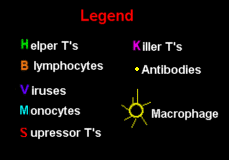
|
1) It all starts with a breech in our initial security system. A virus can enter our bodies through any break in the skin any or opening
at all. Some viruses can be contracted orally, some through cuts and scrapes and some through sexual intercourse. Usually any
exchanging of body fluids will do it. Once the virus is inside our body, the action begins. | 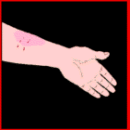 |
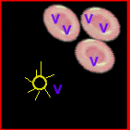 |
2) The immune system begins its response when a white blood cell, usually a macrophage, comes in contact with a virus and
devours it. Of course, this doesn't stop all the other infecting viruses from spreading throughout the host's cells. Our immune
system usually comes into play after the viruses have already done most of their infecting. |
|
3) After the macrophage gets a good taste of the virus, it gives up little pieces of the virus, which are displayed on its outer shell.
These little virus samples are called antigens. These antigens act as homing beacons for leukocytes. Basophils are also
created, and they begin to release histamines. From here Inflammation is initiated as the first step towards overcoming the
infection. | 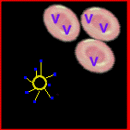 |
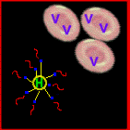 |
4) Now specialized helper T cells identify the antigens and form a union with the macrophage. This new partnership stimulates
the creation of lots of different chemicals, such as cytokines, all of which help establish intercellular communication to help
mobilize the cells for the fight. It takes awhile for the body to produce the killer T-cells specifically designed to target the virus.
Hence the reason most people take seven to ten days to recover from the flu.
|
|
5) At this point, helper T's and killer T's are rolling off the assembly line by the dozen. Chemical signals also cause an increase
in the production of phagocytes. As all of this is happening, the matured helper T's are releasing chemicals which in turn signal
B cells to multiply and start to manufacture antibodies. Finally the body's soldiers are trained and ready to go.
| 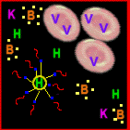 |
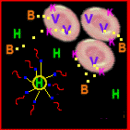 |
6) Now, the newly made killer T cells begin their retaliation by puncturing the already infected host cells. The B cells then release
antibodies, which bind to the viruses inside. This system destroys some of the lethal invaders and makes others more susceptible
to attack from the phagocytes.
|
|
7) With antibodies helping to suppress the viruses, the macrophages are able to destroy viruses more easily. They are soon
able to bring the infection under control. Monocytes help to clean up the mess of dead viruses and cells left behind from the
attack, forming the yellow substance most of us call puss. All the active T and B cells are suppressed and turned off by the
suppressor T cells.
| 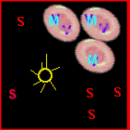 |
8) The infection is now completely flushed from the system. Only memory cells remain behind, to keep the body on guard if the
same virus attacks again.







